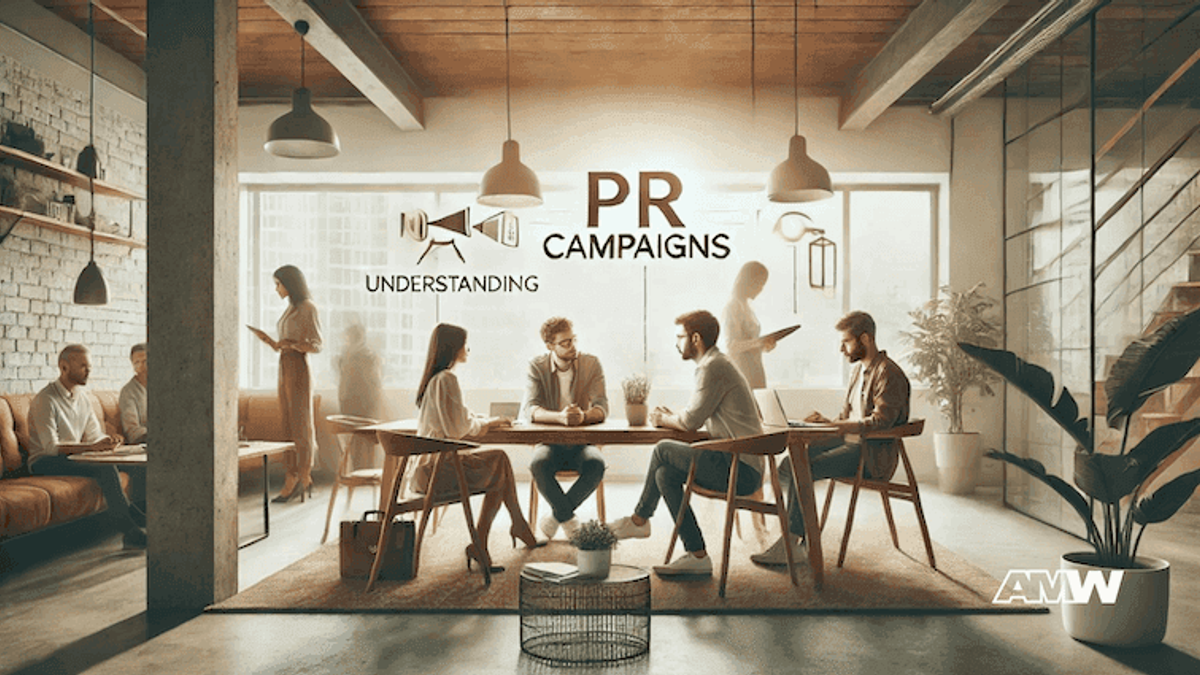What is a PR Campaign? A Comprehensive Guide for Beginners

Effectively communicating your brand's message is crucial. This is where a Public Relations (PR) campaign comes into play. A PR campaign is a strategic communication process that helps organizations and the public build mutually beneficial relationships. It is designed to raise awareness, shape public perception, and enhance brand identity.
Quick Summary
A successful PR campaign is essential for enhancing a brand's reputation and fostering positive relationships with the public and media. Key elements include thorough research, clear objectives, strategic messaging, and selecting effective communication channels. Unlike advertising, which focuses on immediate sales through paid placements, PR aims for long-term reputation building through earned media. By measuring KPIs, such as media coverage and audience engagement, businesses can evaluate the
PR campaigns are vital for business growth and brand reputation. They help manage the public image of a company, launch new products, and address crises.
Understanding PR Campaigns

What is a PR Campaign?
A PR campaign is a coordinated series of activities aimed at achieving a specific objective related to public perception and communication. The process involves creating press releases, engaging with media, and using social media to reach the target audience with the goal of generating media coverage and fostering a positive brand image.
Ready to Grow Your Business?
Get a free consultation and custom strategy tailored to your goals.
Definition and Key Elements
A public relations campaign typically involves:
- Research and Planning:Understanding the audience and setting clear objectives.
- Strategic Communication:Crafting key messages and selecting appropriate media channels.
- Implementation:Executing the planned activities and engaging with the audience.
- Evaluation:Measuring the campaign's success through various metrics such as media coverage, site traffic, and social media followers.
Differences Between PR Campaigns and Advertising Campaigns
While both PR and advertising aim to promote a brand, there are distinct differences. Advertising involves paid placements, such as PPC ads, whereas PR campaigns rely on earned media, such as news coverage and social media buzz. PR focuses on building a positive reputation and long-term relationships with the public, whereas advertising aims for immediate sales impact.
The Role of PR in Business

Enhancing Brand Image
A well-executed PR campaign can significantly enhance a brand's image. Through carefully crafted press releases and strategic media engagements, a company can position itself positively in the eyes of its audience.
Building Relationships with the Public and Media
Successful PR campaigns are built on strong relationships with media outlets and the public. PR professionals work to establish trust, ensuring that the brand's messages are well-received.
Crisis Management
One of the critical roles of PR is managing crises. When a company faces negative publicity, a quick and effective PR response can mitigate damage to its brand reputation. A successful PR campaign requires a proactive approach to potential issues, ensuring that the brand maintains a positive reputation even in challenging times.
Key Takeaways
A successful PR campaign involves thorough research, strategic planning, and effective communication. By understanding the nuances of public relations campaigns, businesses can create messages that resonate and leverage media channels to maximize their reach. Whether through digital PR campaigns, social media marketing, or traditional media coverage, the goal is to enhance brand identity and drive positive engagement.
Components of a PR Campaign

Creating a successful PR campaign involves several critical components that work together to achieve the desired outcomes. These components include research and analysis, setting objectives and goals, strategy development, implementation, and monitoring and evaluation. Understanding and effectively managing each of these elements can significantly increase the likelihood of a campaign's success.
Research and Analysis
Identifying Target Audience
The foundation of any effective public relations campaign is a thorough understanding of the audience. This involves identifying the demographic, psychographic, and behavioral characteristics of the people you want to reach. Understanding your audience helps you customize your messages and choose the best ways to communicate.
Analyzing Market Trends and Media Landscape
Staying informed about industry trends and the current media landscape is essential for creating successful PR campaigns. This involves monitoring the latest news, understanding what topics are currently resonating with the public, and identifying which media outlets are most influential within your industry.
Setting Objectives and Goals
Defining Clear, Measurable Goals
A successful PR campaign requires well-defined objectives that are specific, measurable, achievable, relevant, and time-bound. These goals should align with the objectives and provide a clear direction for the campaign. For example, a goal might be to increase website traffic by 20% over the next three months through enhanced media coverage and social media engagement.
Aligning PR Goals with Business Objectives
It's crucial that PR goals support the broader business objectives. If a company's goal is to enhance its brand reputation, the PR campaign should focus on generating positive media coverage and engaging with the audience in a way that reinforces the brand's values. Aligning PR goals with business objectives ensures that the campaign contributes to the company's success and growth.
Strategy Development
Crafting Key Messages
The messages you convey during a PR campaign should be clear, consistent, and aligned with your brand identity. These messages will serve as the basis for all communication efforts, whether through press releases, social media posts, or media interviews.
Choosing Communication Channels
Selecting the correct communication channels is important for reaching your target audience effectively. This could include traditional media outlets like newspapers and TV, digital platforms like blogs and online news sites, and social media channels. A good PR campaign uses a mix of these channels to maximize reach and engagement. For instance, a press release might be distributed to major news outlets while simultaneously being shared on social media platforms.
Implementation
Executing the PR Plan
Once the strategy is in place, the next step is to implement the PR plan. This involves coordinating all activities, such as distributing press releases, pitching stories to journalists, organizing events, and managing social media campaigns. The PR team needs to ensure that all elements of the campaign are executed smoothly and in alignment with the overall strategy.
Coordinating Media Outreach
Effective media outreach is a cornerstone of a successful PR campaign. This includes building relationships with journalists, bloggers, and influencers who can help amplify your message. Personalized pitches and timely follow-ups are essential for securing media coverage. For example, a carefully crafted press release about a company's innovative campaign can lead to significant media attention and increased brand visibility.
Monitoring and Evaluation
Tracking Campaign Performance
Monitoring the performance of a PR campaign is crucial for understanding its impact. This involves tracking various metrics such as media coverage, social media engagement, website traffic, and overall brand mentions. Google Analytics and other tools can give insights into how the campaign is performing.
Measuring Success with KPIs
Ready to Grow Your Business?
Get a free consultation and custom strategy tailored to your goals.
Key Performance Indicators (KPIs) help measure the success of a PR campaign against the defined objectives. Common KPIs include the number of press releases published, the reach and sentiment of media coverage, increases in social media followers, and website traffic. For instance, a successful PR campaign might be measured by a 30% increase in positive media coverage and a significant boost in social media followers.
Understanding these can help PR professionals create more effective and impactful campaigns. By focusing on research, strategic planning, and careful execution, you can develop a comprehensive PR campaign that drives meaningful engagement and contributes to the overall success.
Steps to Create a PR Campaign

Creating successful PR campaigns requires a methodical approach that involves several key steps. Each step is crucial for ensuring the campaign's success and maximizing its impact on the target audience. Here's a step-by-step process to help you craft a comprehensive PR campaign:
Initial Research and Situation Analysis
The first step is conducting thorough research and a situation analysis. This involves understanding the current state of your brand's reputation, identifying key competitors, and analyzing market trends. For example, if you are planning a digital PR campaign for a new product launch, you would need to assess the competitive landscape and determine how your product stands out.
Identifying the Target Audience
Understanding your audience is important for any successful PR campaign. This involves categorizing your audience based on demographics, psychographics, and behavior.
Assessing Media Landscape
Understanding which media outlets and platforms are most influential in your industry helps you strategize your media outreach. By identifying key journalists, bloggers, and influencers, you can tailor your pitches to increase the likelihood of media coverage.
Developing the PR Strategy

Crafting Key Messages
The core of your PR strategy lies in the key messages you want to communicate. These messages should align with your brand and resonate with your audience.
Setting Objectives and Goals
Clear, measurable objectives are essential for guiding your PR efforts. These should be specific, achievable, and aligned with your overall business goals. For instance, your objective might be to increase brand mentions in major news outlets by 30% within six months.
Choosing Communication Channels
Selecting the right mix of communication channels is vital for reaching your target audience effectively. This could include traditional media, online platforms, social media, and direct outreach. For a comprehensive PR campaign, it's often beneficial to use a combination of these channels.
Creating the PR Plan

Detailing the Plan
With your strategy in place, the next step is to create a detailed PR plan. This should outline the activities, timelines, and resources required for the campaign. For example, your plan might include a schedule for press releases, social media posts, and events.
Budgeting
Allocating a budget for your PR campaign ensures that all planned activities can be executed effectively. This includes costs for media outreach, event planning, content creation, and any other necessary expenditures.
Execution and Coordination
Launching the Campaign
Executing the PR plan involves coordinating all the activities outlined in your plan. This includes distributing press releases, pitching stories to journalists, organizing events, and managing social media marketing. For instance, if you are launching a new product, you might organize a press event, distribute a press release, and simultaneously run a social media campaign to raise awareness.
Engaging with Media and Influencers
Effective media and influencer engagement are crucial for gaining media coverage and driving the campaign's success. This involves building a network with journalists and influencers, providing them with compelling stories, and ensuring timely follow-ups.
Monitoring and Adjusting the Campaign
Tracking Performance
Monitoring the performance of your PR campaign is essential for understanding its impact and making necessary adjustments. This involves tracking metrics such as media coverage, site traffic, social media followers, and overall engagement.
Evaluating Success with KPIs
Key Performance Indicators (KPIs) help measure the success of your PR campaign against your defined objectives. Common KPIs include the number of press releases published, the reach and sentiment of media coverage, and increases in social media followers and website traffic. For example, a successful PR campaign might be measured by a significant increase in positive media coverage and a substantial boost in social media engagement.
Adjusting Strategies
Based on the performance data, you may need to adjust your strategies to optimize the campaign's impact. This could involve tweaking your key messages, changing your media outreach approach, or increasing your social media efforts.
By following these steps, PR professionals can create well-structured, effective PR campaigns that not only raise awareness but also enhance brand reputation and drive business growth. Whether you're working on a small local campaign or a large international one, these steps provide a solid foundation for success.
Ready to Grow Your Business?
Get a free consultation and custom strategy tailored to your goals.
Characteristics of a Good PR Campaign

Creating successful PR campaigns involves understanding and implementing key qualities that distinguish a good PR campaign from an average one. The following characteristics are essential for a public relations campaign to achieve its objectives and make a significant impact.
Key Qualities
Clear and Consistent Messaging
A hallmark of a good PR campaign is clear and consistent messaging. The messages should be simple, straightforward, and aligned with the brand identity. Consistency across all channels ensures that the target audience receives a cohesive message, reinforcing the campaign's objectives.
Strategic Use of Media Channels
Effective use of media channels is crucial for the success of any PR campaign. PR professionals must strategically select the appropriate media outlets and platforms to reach their target audience. This involves a mix of traditional media, such as newspapers and television, and digital platforms, including social media, blogs, and online news sites. For instance, a digital PR campaign targeting millennials might prioritize social media marketing on platforms like Instagram and Twitter, while a campaign targeting business professionals might focus on LinkedIn and industry-specific publications.
Strong Relationship-building with Media and Influencers
Building strong relationships is vital for a successful PR campaign. PR professionals should cultivate relationships with journalists, bloggers, and influencers who can help amplify the campaign's message. This involves regular communication, providing valuable content, and being responsive to their needs. A press release about a launch can gain significant traction if shared by influential bloggers and social media personalities.
Measurable Results
A successful PR campaign requires measurable results to evaluate its effectiveness. KPIs provide valuable insights into the campaign's impact.
Measuring a press release can be done by looking at how much media attention it gets and the increase in website visitors after it's released. By keeping track of these numbers, PR professionals can understand how well the campaign did and use that information to make decisions for future campaigns.
Conclusion

Summary of Key Points
In this comprehensive guide, we've explored the essential components and characteristics of successful PR campaigns. We began by defining what a PR campaign is and its importance in business. We delved into the key components of a PR campaign, including research and analysis, setting objectives, strategy development, implementation, and monitoring. We also highlighted the critical characteristics of a good PR campaign, such as clear messaging, strategic media use, strong relationship building, adaptability, and measurable results.
By understanding these elements, PR professionals can craft campaigns that effectively raise awareness, enhance brand identity, and drive business growth. From the initial research phase to the execution and evaluation, each step is vital for ensuring the campaign's success and achieving the desired impact on the target audience.
Importance of PR Campaigns for Business Success
PR campaigns are integral to business success as they help shape public perception, manage brand reputation, and build strong relationships with key stakeholders. A well-executed campaign can lead to increased media coverage, greater brand visibility, and a positive reputation, all of which contribute to long-term business growth. By focusing on clear messaging, strategic media use, and strong relationship-building, businesses can ensure their PR efforts are effective and impactful.
FAQ

What is a press campaign?
A press campaign is a focused effort to generate media coverage and public interest through press releases, media pitches, and other communication tools aimed at journalists and news outlets. This type of campaign is designed to raise awareness and enhance the brand's reputation by securing positive media coverage.
How do you create a press campaign?
Creating a press campaign involves several steps:
- Identifying your target audience
- Setting clear, measurable objectives
- Developing key messages that align with your brand identity
- Selecting appropriate media channels for reaching your audience
- Executing the campaign by distributing press releases and engaging with media outlets
- Monitoring the campaign's effectiveness through metrics such as media coverage and website traffic
What makes a good PR campaign?
A good PR campaign is characterized by:
- Clear and consistent messaging
- Strategic use of media channels
- Strong relationships with journalists and influencers
- Adaptability to changing circumstances
- Measurable results to evaluate the campaign's success
What is a successful PR strategy?
A successful PR strategy effectively communicates the desired message to the target audience, builds and maintains positive relationships with the media and public, and achieves the set objectives through carefully planned and executed tactics. This involves thorough research, clear goal setting, strategic communication, and continuous evaluation and adjustment.
By focusing on these aspects, PR professionals can create successful PR campaigns that not only raise awareness but also drive meaningful engagement and enhance the brand's reputation. Whether it's through traditional media, social media marketing, or innovative digital campaigns, the key is to be strategic, adaptable, and results-driven.

Maria Kanic is a Social Media Manager at AMW with expertise in digital campaigns, social media strategy, and brand communications.
Ready to Grow Your Business?
Get a free consultation and custom strategy tailored to your goals.